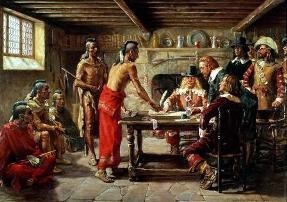
Timing could not have been worse for Anne Hutchinson and her party. Founded in 1621 as a commercial enterprise under the aegis of the Dutch West India Company, which administered and virtually controlled it, the Dutch colony of New Netherland was largely developed around the fur trade along the Hudson River corridor from New Amsterdam (today's Manhattan) to Fort Orange (today's Albany). New Netherland leaders established credible reciprocal relations with many of the Indian bands located in areas that were important to their commercial operations. Trade, particularly Indians gathering beaver for the fur industry, was of prime importance to the Dutch, although they also transported to the New World their cultural heritage of laws, religion, agricultural practices, architecture, inheritance customs and political institutions which had a far reaching impact on the development of New York. The area where Anne and her party settled was claimed as part of New Netherland by the Dutch government's 1621 grant to the Dutch West India Company of all the territory between the 38th and 42 degrees of latitude, roughly from the Delaware River to the Connecticut River. The claim was reinforced by a local purchase from a Lenape chief by colonial authorities in 1640. The area was not part of the Hudson corridor, with the lucrative lure of the fur trade, but the agreement had value as re-inforcing the Dutch colony's claims and strengthening the region as a buffer against intrusion by other European powers and hostile Indians. They named it Vreedlant, after a town in Holland. New Netherland officials invited settlement from colonial refugees, mostly English, who were required to pledge allegiance to the home government of the States-General and the Dutch West India Company, in return for the promise of religious and commercial freedom, local political autonomy and a moratorium on land taxes. By 1642 the Lenape had disavowed the earlier sale, claiming the chief had acted beyond his authority, and that the scarcity of settlement had effectively nullified the earlier agreement. This dispute highlighted different views on land ownership between the Indians and the Dutch, who regarded the 1640 purchase as binding. By this time, Willem Keift, Director of New Netherland, had begun to institute a more aggressive policy toward the Indians, over the objections of his council and most colonists. In an effort to raise revenue, and help make the colony profitable, Keift began requiring tribute or contributions from the Indians to help cover the expenses of protecting the colony from enemy native groups in the region. The Indians rejected this view, claiming that they protected the colonists by alerting them to impending attacks and providing food and other provisions to the Europeans at times of need. Perhaps more importantly, they recognized the land as theirs and the Dutch as intruders. Additionally, a murder of a Dutch settler by an Indian in 1641, in retaliation for a native murder years earlier, touched off a series of events that led to a massacre of scores of Indians by the Dutch in Manhattan and along the Hudson River in New Jersey in early 1643, often called the Pavonia massacre. A general conflict erupted between the colony and the Lenape, including the Indians in this area. Anne's arrival overlapped with perhaps the worst period of this war between New Netherland and the Indians. |
Last updated: March 31, 2012
